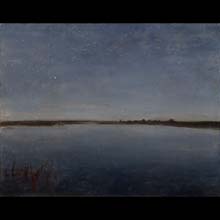
material: oil on canvas
dimensions: 58 × 73 cm
description: Sleeping nature is the only “character” of this poetic nocturne, one of the first works by Chełmoński devoid of the human presence. The simplified composition was excellently described by the painter and art critic Stanisław Witkiewicz, privately a friend of the artist and an ardent promoter of his talent: “The starry sky, separated from the waters of the lake by a thin streak of land in the distance. Silence and tranquillity. Excellent tonality. According to astronomers, constellations like these do not exist in the sky in reality. They say these are only randomly painted tiny dots – this accusation does not concern the artistic quality of the painting, though. Truth in art does not depend on the authenticity of the portrayed scene – Chełmoński’s sky with its astronomical chaos is utterly real.” Chełmoński sent Starry Night and three other paintings including Forest Track for the exhibition held at the Towarzystwo Zachęty Sztuk Pięknych [Society for the Encouragement of the Fine Arts] in Warsaw, popularly referred to as the Zachęta. In the atmosphere of dispute, the jury rejected three of the paintings, accepting only Forest Track. Chełmoński exhibited the other three controversial compositions at the private Salon of Aleksander Krywult. Nevertheless, Starry Night was also presented at the Zachęta several years later, in 1890, at the first retrospective exhibition of the artist. Aleksandra Krypczyk
exposition: The Gallery of 19th Century Polish Art in Sukiennice,
The Cloth Hall, 1, Main Market Square
key: Realism, polish impressionism, beginnings of symbolism >>>
dimensions: 58 × 73 cm
description: Sleeping nature is the only “character” of this poetic nocturne, one of the first works by Chełmoński devoid of the human presence. The simplified composition was excellently described by the painter and art critic Stanisław Witkiewicz, privately a friend of the artist and an ardent promoter of his talent: “The starry sky, separated from the waters of the lake by a thin streak of land in the distance. Silence and tranquillity. Excellent tonality. According to astronomers, constellations like these do not exist in the sky in reality. They say these are only randomly painted tiny dots – this accusation does not concern the artistic quality of the painting, though. Truth in art does not depend on the authenticity of the portrayed scene – Chełmoński’s sky with its astronomical chaos is utterly real.” Chełmoński sent Starry Night and three other paintings including Forest Track for the exhibition held at the Towarzystwo Zachęty Sztuk Pięknych [Society for the Encouragement of the Fine Arts] in Warsaw, popularly referred to as the Zachęta. In the atmosphere of dispute, the jury rejected three of the paintings, accepting only Forest Track. Chełmoński exhibited the other three controversial compositions at the private Salon of Aleksander Krywult. Nevertheless, Starry Night was also presented at the Zachęta several years later, in 1890, at the first retrospective exhibition of the artist. Aleksandra Krypczyk
exposition: The Gallery of 19th Century Polish Art in Sukiennice,
The Cloth Hall, 1, Main Market Square
key: Realism, polish impressionism, beginnings of symbolism >>>












